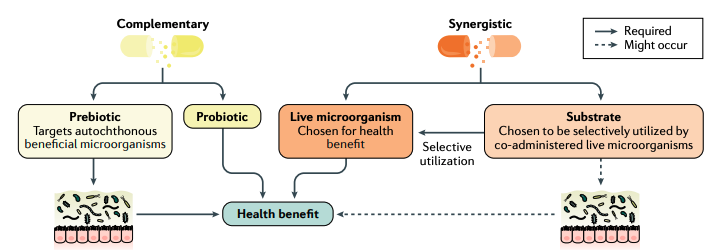*Geek Box: Synbiotic
You have no doubt come across the terms ‘probiotic’ and ‘prebiotic’ before. To recap, probiotics are defined as live microorganisms that, when administered in adequate amounts, confer a health benefit on the host” (3). These are strain-specific bacteria with evidence for human health outcomes from randomised controlled trials.
Prebiotics are defined as a “selectively fermented ingredient that allows specific changes, both in the composition and/or activity of the gastrointestinal microbiota that confers benefits” (4). The key characteristics of prebiotics include resistance to breakdown by gastric acid, resistance to enzymatic breakdown and absorption in the small intestine, and selective fermentation in the large intestine/colon, resulting in selective growth and/or activity of beneficial bacterial populations and associated health benefits. Classification as prebiotic is to date confined to inulin, oligofructose [FOS] and galactooligosaccharides [GOS], for which there is evidence of benefits to human gastrointestinal health.
So, what is a ‘synbiotic’? The International Scientific Association for Probiotics and Prebiotics [ISAPP] has defined a synbiotic supplement as “a mixture comprising live microorganisms and substrate(s) selectively utilized by host microorganisms that confers a health benefit on the host” (5). For example, a synbiotic supplement may contain a number of specific probiotic strains of bacteria with an additional dose of FOS.
There are two categories of synbiotic supplement: complementary synbiotic and synergistic synbiotic (5). A complementary synbiotic is one where the included components have previously met the criteria for probiotic and prebiotic, respectively, i.e., there is evidence for their separate effects. A synergistic synbiotic is composed of live microorganisms and a selective substrate, but neither needs to satisfy the criteria for probiotics and prebiotics. Rather, it is intended that synergistic synbiotics work together, and any study investigating a synergistic synbiotic must demonstrate selective utilisation of the substrate by the accompanying microorganisms, and demonstrate a health benefit to the consumer, in the same study. It should be noted that the term ‘syn’ in synbiotic does not refer to synergy or to symbiosis, but rather denotes ‘together’, indicating the co-administration of the microorganisms and selective substrate.

Figure from (5) illustrating the differences in definition between complementary and synergistic synbiotic.
